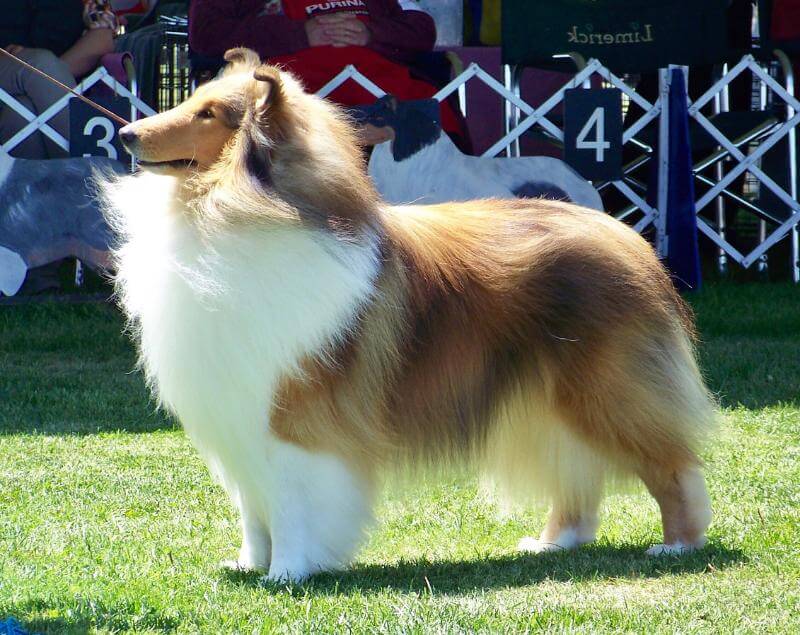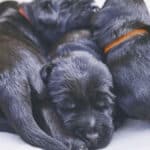What a thrill to judge the Bitch Classes at the 2022 Collie Club of America National Specialty Show. It was a lifelong dream, realized 49 years after I attended my first National. I will share some of these things as a judge, and part of a write-up of my judge’s critique. When I mentor, there are a few things that I share with breeders and then other things for judges. I believe education is extremely important and should be ongoing in our sport. If you ever stop learning, I think that would be the time to get out. This year, I received my 25-year Judges’ Badge.

Judging the Collie
As a judge of multiple breeds, I am keenly aware of the fine nuances of each breed. As a Collie breeder-judge, the expectation is that I know those nuances to the depth and breadth of the Standard—and then beyond.
The Collie is often called a “head breed,” and it is, but it is so much more. When I walk in the ring, I look for balance, type, and curves. I was told many years ago that the Collie is all curves, and I never forgot it.
Correct Proportions
First, there is an initial overview of the class. From the profile view, you should easily note if the body “is a little longer than tall,” the neck is in balance with the body, and if you draw a line through the tip of the ear going straight down to the ground, that perpendicular line should fall in front of the front feet. Some handlers do show their dogs with the head pushed back, but even then; the ears should not be in-line with the shoulders.
You are looking for a level topline and dogs that are standing “four-square” in a rectangular pattern. After walking down the line, and getting your first glimpse of heads and expressions, you’ll see the class move. At this point, a dog or two may catch your eye because of a beautiful expression, or it might be their side gait that catches your eye. I wait until I can touch them.
Judging the Collie’s Head
The exam will take a little longer, to determine the fine details of the head and consider the overall virtues of each dog. As with most Herding breeds, approach on an angle. As per the Collie Standard, you only need to see the front teeth in our breed to determine if it is a correct scissors bite.
You can take another look at the expression at this time, but I like to wait until after I’ve moved them to spend time on it. I lift the head into one hand as I talk with the handler. I use my right hand to feel the head. What I am feeling for are flat zygomatic arches. Along the sides of the head, the zygoma are at the ventral and lateral rim of the eye. Feel. It should be like touching glass; flat and not bowing out. Allow your hands to go over the backskull to feel if it’s flat without falling off in the back.
I look down at the head to make sure the muzzle and skull are balanced and appear as a blunt wedge, without being flared out in backskull (cheeky) or pinched in muzzle (snippy). The head is never overdone and should be “inclined to lightness and never appear massive.” Now, gently tilt the head sideways so that you can see the profile to determine if the muzzle and skull are the same length and that the stop is “slight but perceptible.” Determine if the skull is parallel to the muzzle. Lastly, check to see if there is any depth of head from the skull to the throat. Run your finger along the lower jawbone to see if it widens as you go back. Now, go over the body.
Collie’s Shape and Structure
Consider the Collie a “moderate” Herding breed. There should be no excessive angles. Check between the forelegs to determine the amount of prosternum. This projection of the rib cage should reach at least to the point of shoulder. If you have to “dig” into the coat to find the prosternum, it is most likely lacking and will have a direct impact on how the dog gaits. In my opinion, our breed has a problem at this time with short upper arms. The Collie is not supposed to be built that way. For the dog to have good reach, it needs balance of its front assembly. We are a “Working/Herding” dog. Yes, we are a head breed, but most good breeders breed for both head and body.
The neck should blend into the level back, with a slight slope at the croup. Remember, the Collie is all “curves!” The tail is set on to be carried “gaily but not over the back.” The tail should reach the hock. The loin should be short, with any length being carried in the ribs. Angles should be matched, front to rear. Hocks should be perpendicular to the ground and feet should be straight, turning neither in nor out. Bone is round, and feet are oval with toes well-arched.
Collie’s Movement
When you move the dog down and back, you are looking for a dog that is a single-tracking breed and will come closest to single-tracking depending on the size of the ring and the speed of the dog. Any deviation away from this is a fault. The dog should come back and stand naturally, and show you type, balance, and yes, that Collie expression. (We will get into that a bit more later.)
Send the dog around to view the side gait for the second time. The Collie is to reach to, or past, its nose in full extension, having a balanced kick in the rear. Gait is to be effortless and show no wasted energy, thus the feet should not be too far off the ground. The topline is level, but may have a slight rise over the loin. Collies should not roll. That is a fault.
Collie’s Expression
When I make my final decision, first the dog must have the expression I look for in all Collies. It’s intelligent, quizzical, melting, and a ‘want to please you’ look. Then, I consider the head virtues with the overall dog, which includes structure, movement, and condition. I find if the expression and the eye placement are correct, the head is going to be anywhere from acceptable to exceptional—but they still must work herding sheep all day. Remember, we judge on virtues. If you find a head that you think is outstanding, reward it. Good luck and enjoy our wonderful breed!
A Few Take-Aways from Judging the 2022 National
I had a smaller than usual entry because this year’s National was held in Salt Lake City, Utah. Both my Smooth and Rough bitch entries had exquisite Collies. The Rough Collie entry was deeper in quality. I judged the entry over a three-day period.
Judging the Smooth Collie
My Smooth Winners Bitch Class was lovely. My Winners Bitch (Heiress ‘Ohana, bred by Jessica, Jennifer & Lana Group, owned by Jennifer Tenneson and Jessica Wittman) came from the 6-9 Puppy Class and was everything I could want in one package. She is a blue bitch with the Collie expression I look for. Putting my hands on her head, I found flat zygomatic arches, a flat skull, and a beautiful profile. This bitch could move like the wind. Her body was a pleasure to go over as well. She had the expression, type, and balance that I covet, and thus, was awarded Winners Bitch. I found out that this was her first show, at only six months and one day old.
My Reserve Winners Bitch, (Cyndella A Beautiful Silhouette, bred by Kelley Nelley and Elena Geldkop, owned by Kelly Neeley and Caitlin Neeley) was a tri bitch that had a beautiful, long, lean, clean head with a lovely expression. She was a good mover down and back, and excelled on side gait. She came out of the Bred-By-Exhibitor Class and was also a puppy. I would have taken either of these bitches home!
Judging the Rough Collie
Prior to judging, I was thinking about my Rough Winners Class at breakfast. I knew I would have a lot of tough choices. I had such depth of quality in each class and I knew that each class winner could be a possible Winners Bitch. When I saw my class lined up for the first time, I had to take a deep breath. It was more beautiful than I could have imagined. My second look at the line-up, I narrowed it down to seven bitches. I went over the cleanliness of head, looked at expression, and moved them again, and I pulled out six. I eventually had two sable and one sable merle bitch center stage and on the centerline of the ring.
My heart helped choose Winners Bitch (Alaric N Cantera’s Breathless, bred by Patricia A and Dr. Allyson Caldwell, owned by Patricia Toledano). Every time I looked into her face I saw that melting, quizzical yet willing to do whatever their owner wanted, look. In my opinion, this bitch was mature, in the best condition she could be in, and in full bloom. She exuded Collie type and was balanced, with all curves. Her head was a textbook head, with the sides as clean as glass, the backskull flat and filled with the occiput up slightly. Her rounded muzzle and finish added to her expression.
She possessed a profile with two parallel planes, with the slight stop. Her balance of muzzle-to-skull was perfection and she had no depth of head. Her structure was correct, with her front close to a 90-degree angle and with a correct upper arm. The prosternum was where it should be, with the chest dropping to the elbow. Her lovely arch of neck flowed into a straight back, with a proper croup and tail set. With matching rear angles and good feet, she moved freely down and back, and her side gate was flowing; not putting a foot wrong.
My Reserve Bitch (Overland Playtime, bred and owned by Marcy & Mike Fine and Susan Pierce) was a beautiful sable merle bitch. She was well-balanced and excelled in type and movement. Her head was also a textbook head with a lean blunt wedge, no depth, and clean on the sides. She had a lovely expression, but that day was not her day for the big win. I understand the Reserve did finish her.
Final Thoughts
I had the time of my life judging the National. It went by way too fast. I want to thank everyone who entered dogs under me, because each one of you brought me joy!
I’m hoping that by guiding you through judging a Collie more judges will feel confident when they judge our breed. I do like to remind judges: We are a purpose-bred dog, but yes, head is important. Are you able to find both a great head and good body? Yep, you sure are. They might not be at every show, but you’ll find that quality at most shows.
I will be in Orlando if anyone wants a parent club approved mentor. I’ll be happy to help when my time allows or I will find someone who can help.










